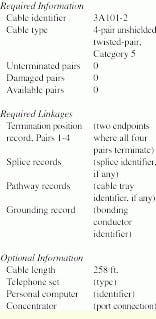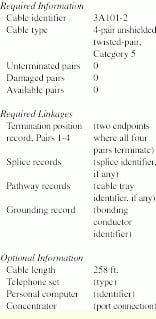T.J. Roe
Telecommunication Resources & Consulting Services
Cabling contractors and network managers know that labeling the components of a cabling plant when it is installed or upgraded, documenting what has been labeled, and keeping cabling-plant records up-to-date can save time and reduce frustration later when it is time to perform maintenance or troubleshoot a problem. However, the standard that describes documentation of the cabling plant, TIA/EIA-606, "Administration Standard for the Telecommunications Infrastructure of Commercial Buildings," is 81 pages long, making it tempting to avoid documentation.
However, even though TIA/EIA-606 may seem like a complicated standard, you can use just a few building blocks from it to document most installations. Let`s look briefly at the building blocks needed to define a basic link and see how they can be used to generate the reports you`ll need to keep your cabling-plant records updated.
Identifiers
The basic component of the administrative standard is the identifier, a unique designation for a specific element of the telecommunications infrastructure, such as a horizontal cable. The identifier indicates not only the cabling-plant component but also its corresponding record.
Identifiers must be unique, and may or may not be encoded. A coded cable identifier, for example, might be 3A101-2, identifying it as the second cable to room 101, which feeds from telecommunications closet 3A. An equivalent unencoded cable identifier might simply be a number, such as cable #0001.
Records
A record is a collection of information related to a specific element of the telecommunications infrastructure. At a minimum, a record contains required information about the element and its linkages and may also contain optional information. Here is an example:
TIA/EIA-606 requires that every pair or conductor in the cable, whether terminated, unterminated or damaged, be documented in the cable record. This cable record also identifies the closet and terminating hardware at one end of the link and the jack number at the other end:
All terminating-hardware records, whether for connectors or plugs, must include the type of hardware--for instance, Category 5--as well as an identifier for each position that links to the full cable record. An example of an identifier for terminating hardware might be 3A-A17 for a Category 5, 48-port patch panel. A termination position on the patch panel might be labeled 3A-A17-001, which could be port 1, an 8-position jack, terminated in the T568A pattern.
In addition to its identifier, the record for a termination position is required to include cable pair or conductor numbers. If the termination position is a telecommunications outlet, it must also include a user code, such as a telephone number or user-identification number. For example:
The administration standard calls for linkages between cable, terminating hardware and termination position records to be maintained. Pathway and space records, documenting the raceways or other wire-management devices through which the cable run passes, are also required.
Linkages
A linkage is a logical connection between a record and an identifier, or between records. Linkages consist of listings in a record of identifiers for the records of associated components. In the above example of a record, cable 3A101-2 is linked to the connectors at each end, as well as to any splices along its length, the cable tray through which it runs and the grounding or bonding conductor attached to it.
Reports
A report is a collection of information from various records. Reports may be presented in several formats, either on paper or in software; they may take the form of data tables, drawings, floor plans or blueprints. But, if properly done, all formats facilitate tracing connectivity through the basic link from end to end.
Three reports recommended for maintaining the basic link are the end-to-end circuit report, cable summary report and crossconnect report. The end-to-end circuit report traces connectivity from the user outlet to the termination at the telecommunications closet. It covers the basic link and includes the essential information needed for troubleshooting a problem or otherwise working on a circuit--for example, adding dial tone to an unused pair or changing the service. A cable summary report lists all the cables in a cabling plant, including their types and terminating positions. Crossconnect reports are recommended for all termination spaces, such as telecommunications closets and equipment rooms.
When troubleshooting a cabling plant, the identifier found on a component is your link to the complete cable record. Linkages in the record guide you from one end of a basic link to the other.
TIA/EIA-606 specifies that work orders leading to changes in the cabling plant be kept on file, and when implemented, used to update the administrative records of the cabling plant.
Paul S. Kreager, KAI/Level 0-1 Inc.
The Telecommunications Industry Association (TIA, Arlington, VA) released the first draft revision of the TIA/EIA-569 pathway and space standard for industry ballot and comment last December. Approximately 200 technical comments were reviewed at the March TIA TR-41 meeting in Ft. Myers, FL, and at a special interim meeting held in Chicago in April.
Because of the large number of comments received, the pathway and space document has been revised and was released again for industry ballot and comment this spring. Comments on the second draft will be reviewed at the September TIA TR-41 meeting in Ottawa, Canada. Assuming quick resolution of second draft comments, the TIA/EIA-569A standard should be available late this year or in early 1997.
Although it is difficult to know what TIA/EIA-569A will ultimately look like, you can expect many enhancements to the first edition of the standard. Here is a sampling of major items being considered:
Addition of consolidation-point and multiuser telecommunications-outlet pathway and space considerations
Consolidation of all interbuilding specifications into a new annex, anticipating that this annex will eventually be removed from TIA/EIA-569 when the TIA releases an outside-plant standard covering the same material
Addition of a subsection covering the main terminal space in the equipment-room chapter
Addition of furniture pathway and space requirements to the work-area chapter.
Changes made to the guidelines on pathway separation from electromagnetic-interference sources
Deletion of the annex of symbols because the TIA/EIA-606 standard now covers this material
Firestopping becoming a requirement of the standard, instead of being just an informative annex in the original document
Changes in transition-box sizing, equipment-room floor loading, telecommunications- closet layout and vibration specifications.
Paul Kreager is a consultant and educator in the telecommunications infrastructure field. He chairs the TIA TR-41.8.3 Working Group, responsible for the 569 and 606 standards. He can be reached at [email protected].
T. J. Roe, registered communications distribution designer (RCDD), is a consultant with Wilmington, DE-based Telecommunications Resources & Consulting Services, which specializes in design and project management for telecommunications infrastructure projects.



